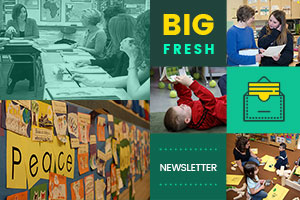Facts are helpful, but rarely are they soulful.
—Bob Goff
Hope
I have a complicated relationship with hope. It’s a tiny word charged with big emotion, and I constantly find it lingering around the edges (and sometimes in the heart) of my life. What is a hope you have right now? What is a hope you’re afraid to admit?
For me, the hope I’m afraid to say is that I hope I’m relevant. In this world where curriculum is more structured and schedules are more structured and literacy is more structured, I wonder if my core beliefs still hold true. Am I able to support and encourage teachers in relevant ways?
I know I’m not alone. As we grow The Lead Learners community, I talk with many instructional influencers, and no matter their school or their experience or their location, they all feel the same pressure. Things are changing. Am I able to help?
Often teachers will say, “Just tell me what to do,” and they’ll pull out a curriculum guide or a packet they purchased or a promise they found on social media, all designed to keep students quiet so teachers can do all the things they don’t have time to do.
Oftentimes in an effort to help, we share information. We believe if teachers just had enough information—about phonics instruction, or trauma-informed responses, or math protocols—then everything would be better.
Did you know that on average, human knowledge is doubling every 13 months? With the rise of AI tools, everyone can get information about everything. No longer is information a gift that we can give.
Here’s the thing: Knowing more doesn’t necessarily mean having more clarity or understanding. With the ease of gathering information at our fingertips, we keep turning to information for solutions.
We are living in a time when we believe if we have the right facts—whether from AI or social media or the right curriculum—then everything can be perfect in our classrooms. If we’re not careful, as coaches, we can get caught in the Facts Trap. We begin to believe that if we give people enough information, then it will lead to change.
We hope information will give peace.
We don’t need more information; we need inspiration. I’ve never had a big bunch of facts change my life. Story, though—story makes a difference. This is why Choice Literacy is valuable. In a world where so many people outside of education are telling those inside schools what to do, Choice Literacy provides a sanctuary for practicing educators to share what’s working, what’s changing, and what they’re adjusting in their classrooms and schools. This week contributors share how they are adjusting to change—plus more, as always.
Shine on,
Ruth Ayres
Editor in. Chief

Tammy Mulligan considers ways to help students feel and know that they belong in the classroom community. The more we broaden our knowledge of others, and discover more about who we are and what we care about, the more our sense of belonging can grow.
Gretchen Schroeder is surprised to find benefits of a stronger community and communication skills through a practical attendance routine in her high school classroom.
Join Ruth Ayres and Stephanie Affinito for The 10-Minute Reset That Keeps Coaches from Burning Out. In just 45 minutes, you’ll experience what it feels like to
- pause the noise with a guided writing prompt that clears your mental clutter.
- restore energy by learning the simple 10-minute habit that builds margin into your day.
- reset in real time so you walk away calmer, more focused, and in control.
Choose the time that works for you.
- Tuesday | Oct. 28 | 11:00 a.m. (EDT)
- Tuesday | Oct. 28 | 2:00 p.m. (EDT)
- Saturday | Nov. 1 | 9:00 a.m. (EDT)
- Thursday | Nov. 6 | 3:15 p.m. (EST)

New members-only content is added each week to the Choice Literacy website. If you’re not yet a member, click here to explore membership options.
Hannah Tills reflects on the importance of career changes in education and how they are not always about working to a higher leadership position. Hannah offers a guiding light for anyone who is wondering if a different position may be calling—even if it means returning to a past role.
Most teachers have, at some point, taken a picture of their class or a particular student and shared that photo with a family, but what if teachers became more intentional about taking and sending pictures? Tiffany Abbott Fuller gives practical ideas for using photos to increase family engagement.
From lesson planning to generating decodable texts, Dana Murphy shares five ways she uses AI as a reading interventionist.
Gwen Blumberg is inspired by a challenging roller derby practice and sees parallels for teachers who are facing challenging situations with changes to literacy curriculums. If something is shifting in your life, this article is sure to offer you confidence in moving forward.

New members-only content is added each week to the Choice Literacy website. If you’re not yet a member, click here to explore membership options.
Mandy Robek offers tips for hosting a student teacher in today’s era of education. This is a must-read for anyone who is supporting the next generation of teachers!
Stella Villalba questions the traditional practices of parent/guardian-teacher conferences. She offers a reflection and a call to action for everyone to consider the possibilities for more connection and equity during conference nights.
Matt Renwick shares 35 actions leaders can take to create a stronger school culture. If you are a new leader, you can use this list and implement one a week throughout the school year.
Quote It:
If you don’t like something, change it. If you can’t change it, change your attitude.
—Maya Angelou
That’s all for this week!



